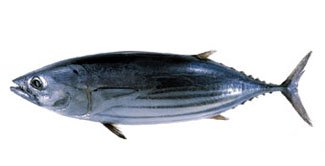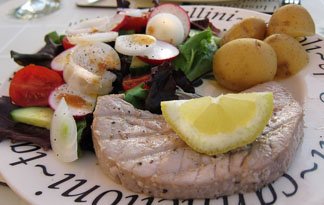Skipjack Tuna Nutrition Facts
Skipjack tuna, which accounts for nearly half of global tuna production, is known for its strong flavor and attractive pink, fatty, and chunky flesh. Skipjack is the most abundant commercial tuna species, common in tropical and warm temperate waters of the Indian, Atlantic, and Pacific Oceans, where it inhabits surface waters in large shoals.
Scientific name: Katsuwonus pelamis. Genus: Katsuwonus, Family: Scombridae.
 |
| Skipjack tuna (Katsuwonus pelamis). Photo credit: U.S. Food and Drug Administration. |
Skipjack is also known by many local names such as Atlantic bonito, oceanic skipjack, skipper, stripe-bellied bonito, Aku (Hawaiian), bonite (French), bonito del Sur (Spanish), palamatu (Italian), and Serra (Portuguese).
Habitat and Biology
Skipjacks are epipelagic fish living in large shoals in tropical warm waters. Adult fish live at depths ranging from 0 to 250 m during the day but are limited to near-surface waters at night. They are opportunistic feeders, preying on any available forage, predominantly small fishes like herring, sardines, and crustaceans, cephalopods, and mollusks.
The lifespan ranges between 6 and 10 years. Adult skipjack tuna measure 70-90 cm and weigh 10 to 16 lbs.
Skipjack matures around 2 years of age and spawns in batches throughout the year in warm equatorial waters.
Description
Skipjacks are athletic, fast-swimming, medium-sized oceanic fish among tuna species. Their scaleless, fusiform body is elongated and rounded. Their body features a purplish-blue back, and silvery lower sides and belly, with 4 to 6 very conspicuous longitudinal dark bands. A strong keel on each side of the caudal-fin base between 2 smaller keels.
Health Benefits of Skipjack Tuna
Skipjack is an oily, saltwater fish. It is one of the finest sources of essential fatty acids, protein, minerals, and fat-soluble vitamins like vitamins A, E, and D.
Skipjack is moderately high; 100 g holds 103 calories and 22 g/100 g (39% of RDI) of protein. Its dark, pink meat is firm and comprises all the essential amino acids in good proportions.
Its lean meat is a good source of polyunsaturated fatty acids (PUFA). Studies suggest a diet rich in fish that is high in omega-3 fatty acids, like canned tuna, can curb or prevent cognitive decline, dementia, depression, neuropsychiatric disorders, asthma, and inflammatory disorders.
Skipjack tuna contains just 0.144 ppm of mercury in its flesh. Hence, the US-FDA categorizes skipjack in the "best choice" section considering mercury levels in its flesh. The recommendation is consumption of 2-3 servings (8-12 ounces) per week for skipjack.
Bonito is a moderate source of omega-3 eicosapentaenoic acid (EPA), docosapentaenoic acid (DPA), and docosahexaenoic acid (DHA) fatty acids. Research studies suggest that these fatty acids, particularly DHA, play an important role in the development of the nervous system, especially in infants and children.
According to Cornell University and the New York Sea Grant Extension Program (2012), the fatty acids play a crucial role in decreasing blood pressure and heart rate and help improve cardiovascular function. For example, research has shown that omega-3 fatty acids decrease the risk of arrhythmias (abnormal heartbeats) that can lead to sudden death.
Bonito contains small amounts of vitamin-A (52 IU/100 g) in its flesh. Nonetheless, its liver carries high amounts of omega-3 essential fatty acids such as ALA, DHA, and DPA, which help maintain healthy mucosa and skin.
Skipjack chunks compose many B-complex vitamins such as niacin and pyridoxine (B-6). It is also a good source of vitamin E, vitamin B12, thiamin, and riboflavin.
Further, it is a natural source of rich minerals including iodine, selenium, calcium, zinc, potassium, phosphorus, and magnesium. Iodine is an important trace element in human nutrition and is essential for thyroid hormone production.
| Principle | Nutrient Value | Percent of RDA |
|---|---|---|
| Energy | 103 Kcal | 5% |
| Carbohydrates | 0 g | 0% |
| Protein | 22 g | 39% |
| Total Fat | 1.01 g | 5% |
| Cholesterol | 47 mg | 16% |
| Dietary Fiber | 0 g | 0% |
| Vitamins | ||
| Folate total | 9 μg | 2.25% |
| Niacin | 15.4 mg | 96% |
| Pyridoxine | 0.85 mg | 6.5% |
| Riboflavin | 0.1 mg | 7.5% |
| Thiamin | 0.033 mg | 2.75% |
| Vitamin-A | 52 IU | <2% |
| Vitamin-C | 1 mg | 1.5% | Electrolytes |
| Sodium | 37 mg | 2.5% |
| Potassium | 407 mg | 8.65% |
| Minerals | ||
| Calcium | 29 mg | 3% |
| Iron | 1.25 mg | 15.5% |
| Magnesium | 34 mg | 8.5% |
| Phosphorus | 222 mg | 32% |
| Selenium | 36.5 mg | 66% |
| Zinc | 0.82 mg | 7.5% | Omega-3 fats (PUFA) |
| EPA (20:5 n-3) | 0.071 g | -- |
| DPA (22:5 n-3) | 0.013 g | -- |
| DHA (22:6 n-3) | 0.185 g | -- |
Buying
Wild skipjack tuna is mainly caught using purse seine nets, hook and line, gill nets, or long-line fishing boats. Most of these catches are destined for canning or pouching.
Skipjack is usually marketed as "chunk-light" tuna. Buy canned or pouched products from authentic brands for superior quality and safety. It is also marketed as fresh, frozen, or dried flakes. In Japan, dried bonito is known as "katsuobushi" (bonito flakes).
Storage
The shelf-life of unopened canned skipjack (light) tuna is up to four years, provided that the product has been stored under normal conditions and is not damaged. Pouched tuna has a shelf-life of up to three years.
As with any seafood products, canned tuna should not be kept at room temperature for extended hours.
Once opened, it must be kept in a refrigerator. If wrapped properly and stored in the fridge, it should last for around three days. For extended storage, transfer the tuna to a glass jar or freezer bag and store it in the freezer for later consumption within the next few months.
Preparation
Fresh tuna is sold as steaks, and sometimes as fillets or chunks (pieces). However, most often, it is canned whole, in chunks, or in brine.
Skipjack meat is strong-tasting and firm, with a pink color.
You can serve it raw (sushi), poached, braised, grilled, baked, or cooked whole (en papillote or al cartoccio).
Here are some serving ideas:
 |
| Skipjack tuna steak recipe. Photo credit: Keith Williamson |
Skipjack (Katsuo) is a popular sushi fish in Japan, where it is enjoyed in sashimi and sushi rolls.
Shaved bonito flakes (katsuobushi) and dried kelp (kombu) are the main ingredients of dashi, a broth that forms the basis of many soups (such as miso) and sauces in Japanese cuisine.
To make Skipjack tuna salad, mix Greek yogurt, fresh lemon juice, mayonnaise, diced celery, diced Spanish onions, and ground black pepper in a separate mixing bowl. Stir well and add this mix to light chunk tuna. Keep it in the refrigerator.
Prepare American-style tuna casserole.
In Filipino cuisine, skipjack tuna stew is prepared in coconut milk - ginataang tulingan.
In many South Asian regions, tuna curry prepared in coconut milk is served over steamed rice.
Tuna is also one of the basic ingredients of vitello tonnato (Piedmontese), an Italian dish that also includes cold veal, anchovies, capers, sandwiches, sauces, omelets, and casseroles.
Safety Profile
The methyl-mercury content of fresh/frozen skipjack tuna is 0.144 PPM, hence categorized as the "Best Choice" fish. The FDA advises that one can eat 2 to 3 servings a week from the "Best Choice" list (adult serving = 4 ounces). In comparison, canned albacore tuna and fresh/frozen bigeye tuna have 0.350 PPM and 0.689 PPM, respectively.
Also read ≻≻-
≺≺ Atlantic mackerel nutrition facts and health benefits.
≺≺ Salmon nutrition facts and health benefits.
≺≺ Trout fish nutrition facts and health benefits.
≺≺ Dover sole nutrition facts and health benefits.
≺≺ Back to Seafood from Skipjack tuna nutrition facts and health benefits.
Further reading (Links opens in new window):
Species Fact Sheets -Katsuwonus pelamis.
Omega-3 Fatty Acids: An Essential Contribution.